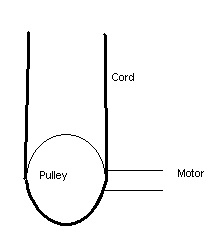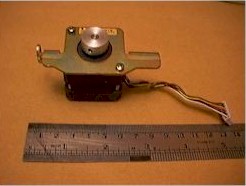

I want my system to use standard corded curtain track, because it is fairly cheap and widely available. This will (with compatible drive system) retain manual control if required e.g. in a power/system failure, or if someone is not aware the system is motorized! Of course you may want to cut the cord as short as possible so you can mount the motor unit up at the top near the track. It's up to you.
Drive System:
The drive must be connected to the curtain track using a pulley coupled to the pull-cord. To retain manual control, the drive system needs to have a free turning output shaft when the curtains are not being operated. A conventional geared DC motor would not be suitable, because the output shaft cannot not be easily turned by hand (by pulling the curtain cord). However, the shaft of a stepper motor turns (fairly) freely when not energized, this along with their high torque & controllable speed allows direct drive so the curtains can still be operated manually using the pull-cord.Selecting a size and type of motor suitable for the job is a bit more tricky. I needed a motor as small and cheap as possible with enough torque for the job. I used the high tech method of trial and error, as I had a few steppers of varying sizes.
You should read this tutorial for information about steppers, if you don't know what they are or how they work.
Here are the motors I tried. Unfortunately most of them either have limited specs printed on the case, or none. But you can get a (very) rough idea from the size as to the available torque. If you read the above you should know the bipolar steppers have more torque than a similar sized unipolar motor.
These were tested under highly controlled conditions(!). I attached a pulley coated in hotmelt glue (to maximize the friction) to the motor under test. This was then looped through the curtain track pull-cord a half turn:
:
I wrote a PIC program to drive the motor using an L6219 IC for the bipolar motors, and 4 NPN transistors for the unipolar. I then ran the motor to test if it could handle the load of the curtains, while 'feeling' how much excess torque was available.
 Unipolar
motor from 5-1/4 inch floppy drive (head position motor). 40mm (W) x 40mm (L)
x 30mm (D). Marked TEAC P.NO.14769070-10.
Unipolar
motor from 5-1/4 inch floppy drive (head position motor). 40mm (W) x 40mm (L)
x 30mm (D). Marked TEAC P.NO.14769070-10.
Result: Fairly puny motor. No good.
 Bipolar
motor from Canon bubblejet printer (printhead position motor). 43mm (Diameter)
x 15mm (D). Marked Airpax S42M100S26, 5.2 Ohms, 3.6 Degrees.
Bipolar
motor from Canon bubblejet printer (printhead position motor). 43mm (Diameter)
x 15mm (D). Marked Airpax S42M100S26, 5.2 Ohms, 3.6 Degrees.
Result: A particularly feeble device. Should have left it in the printer.
Unipolar motor from Fruit Machine (Reel motor). 55mm (Diameter) x 24mm (D). Marked Airpax P/N: S57L048S12-M1, Ohms/Coil: 27.5, Deg/Step: 7.5
Result: This is probably the physical size of motor I would have liked to use. Unfortunately it is pathetic.
Unipolar motor from Mannesman Tally wide carriage dot-matrix printer (printhead position motor). 57mm (L) x 57mm (D) x 41mm (D) (NEMA standard frame size 23). Marked 57SH-46B8B, 10 Ohms, 1.8 Deg.
Result: This is more like it. Can open and close the curtains (just). Driving at 5V pulls 500mA per phase, my driver transistors can't take any more, or I could crank up the voltage a bit.
Bipolar motor from another wide carriage printer. Same size as above. Marked 2 phase stepping motor, A2455-9212, 10.6 Ohms, 1.8Deg./Step, Vexta, Oriental Motor Co.
Result: There ain't no stopping this motor! The weak link in the drive now is the pull-cord slipping on my high-tech pulley.
Found another Bipolar motor from (I think) Epson wide carriage printer. Marked 3.5V XXXXXXXXXXXXXXX. Also frame size 23. .
Result: This motor pulls a lot of current. I need a higher current controller to test the torque, but I'm sure it will be more than capable.
Transmission:
There are a couple of methods to couple the motor & pulley to the pull-cord.
One motorized system called the Drape-Boss requires you to splice in a section of ball-chain (bead-chain) to the pull-cord, which is driven by a special pulley. Is it also possible to replace the entire pull-cord with a section of ball-chain if necessary e.g. if you have curtains whose draw length is greater than the cord loop length. This has the advantage of a non-slip motor coupling. I considered this method, but I wanted to avoid buying replacement chain for each set of curtains (10m at £1 per metre (B&Q prices!) = £10 per track). I also need to use a marker on the pull-cord for position detection using reflective IR sensors which could be difficult with ball-chain because of gaps between the balls!
So I have stuck to the standard cord and pulley. The pulley must be made from or coated with a high friction material e.g. rubber, so the cord does not slip. A friend of mine has turned me a pulley from steel on his lathe. Ihave coated the friction surface in a thin layer of silicone sealant:
{{picture}}